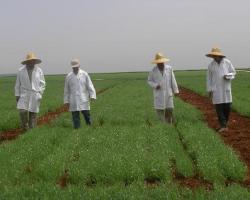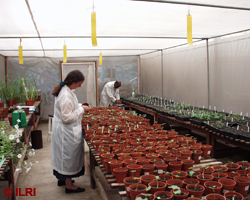Health diagnosis of forage legume genetic resources
Contributors to this page: ILRI, Ethiopia (Jean Hanson, Juvy B. Cantrell, Janice Proud); CIAT, Cali, Colombia (Maritza Cuervo); ICARDA, Syria (Siham Asaad, Ahmed Amri, Kenneth Street, Ali Shehadeh, Natalya Rukhkyan); Bioversity International/ILRI, Addis Ababa, Ethiopia (Alexandra Jorge).
|
A field inspection of grasspea (photo: ICARDA)
Visual virus inspection (photo: ILRI) |
List of pests and diseases of quarantine importance
Forage legumes are susceptible to a wide range of pests and diseases. Click here for more detailed and updated information from the page on the safe movement of germplasm, on this website.
Click the forage legume health table for specific species information about health diagnosis methods to detect some of these diseases.
Options for testing procedures
Recommended methods to detect the presence of each pest or disease:
- Virus (ELISA, TBIA).
- Ascochyta spp. (freezing blotter method, PDA).
- Phoma spp. (freezing blotter method, PDA).
- Botrytis cinerea (PDA).
- Colletotrichum sp. (blotter method).
- Fusarium oxysporum (blotter method).
- Rhizoctonia solanum (blotter method).
- Penicillium sp. (blotter method).
- Ditylenchus dipsaci (nematode test).
- Orobanche spp. (filter wash test).
- Cuscuta spp. (filter wash test).
Testing intervals/seasons
|
|
Testing before material goes into the genebank or to the field is important to reduce transfer of diseases or pests.
Virus
- Test seedlings before transfer to the field for regeneration or during regeneration and rogue infected material.
Fungus
Ascochyta spp., Phoma spp., Botrytis cinerea.
- Test seed lots on entry to genebank.
- Perform field inspection at all stages and rogue infected plants or/and seed.
Nematodes
Ditylenchus dipsaci.
- Perform field inspection at all stages and rogue infected plants or/and seed.
Weeds
Orobanche spp. and Cuscuta spp.
- Perform field inspection at flowering stage, rogue before seed dispersal and burn the plants.
Recording information during health diagnosis
|
The text for this flip book was extracted from: Rao NK, Hanson J, Dulloo ME, Ghosh K, Nowel D, Larinde M. 2006. Manual of seed handling in genebanks. Handbooks for Genebanks No. 8. Bioversity International, Rome, Italy. 147pp. |
The following information should be recorded for each health diagnosis step:
- Accession number (ID number).
- Lot number (ID number).
- Taxonomic identification.
- Date of test (the date that the test was commenced).
- Number of replications (the number of replicates in the test).
- Number of seeds/plants per replication (the number of seeds/plants in each replicate of the test).
- Pre-treatments (pre treatments used for the test).
- Media [the media for the test (fungi)].
- Pathogen tested (name of pathogen tested).
- Test method (method used).
- ID in health diagnosis experiment, e.g. Plot numbers (plot ID number) or entry number of experiment.
- Percentage infection (% of seeds or plants infected).
References and further reading
Albrechtsen SE. 2006. Testing Methods for Seed-Transmitted Viruses: Principles and Protocols. CABI Publishing, Cambridge, USA. pp. 268.
Nan ZB, Hanson J. 1998. Detection of seed borne fungi in Stylosanthes hamata, S. guianensis and S. scabra. Seed Science and Technology 26:333-345.
Nan ZB, Hanson J, Yeshi MW. 1998. Effects of sulphuric acid and hot water treatments on seed borne fungi and germination of Stylosanthes hamata, S. guianensis and S. scabra. Seed Science and Technology 26:33-43.
Rao NK, Hanson J, Dulloo ME, Ghosh K, Nowel D, Larinde M. 2006. Manual of seed handling in genebanks. Handbooks for Genebanks No. 8. Bioversity International, Rome, Italy. Available in English (1.5 MB), Spanish (1.4 MB) and French (1.9 MB).
Comments
- No comments found







Leave your comments
Post comment as a guest